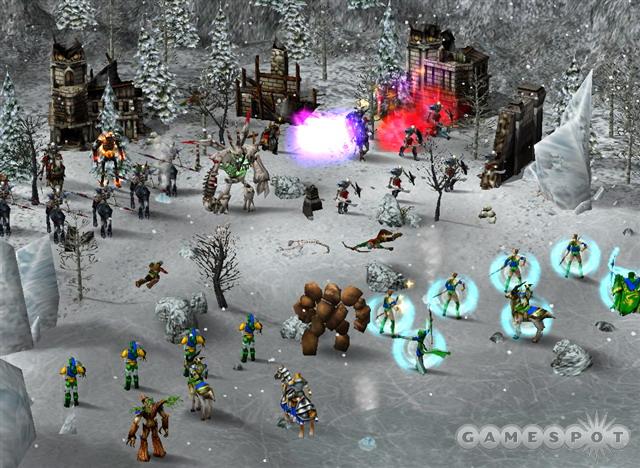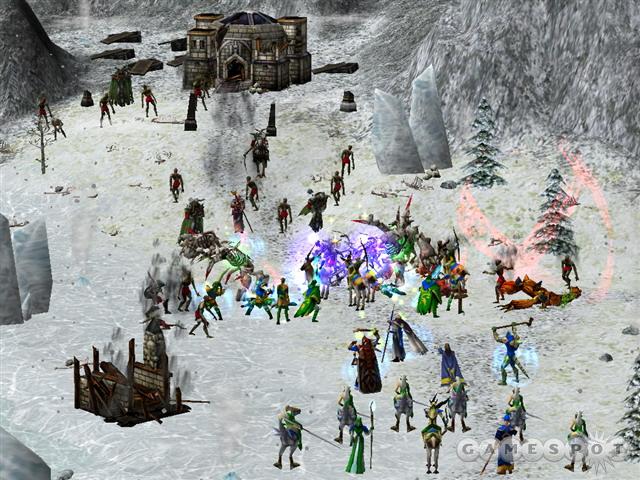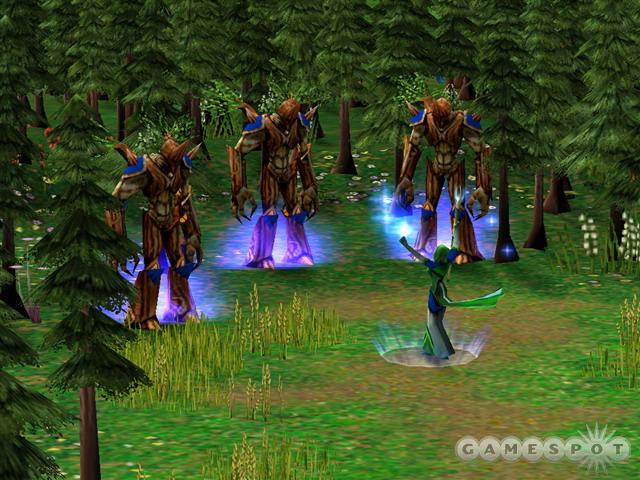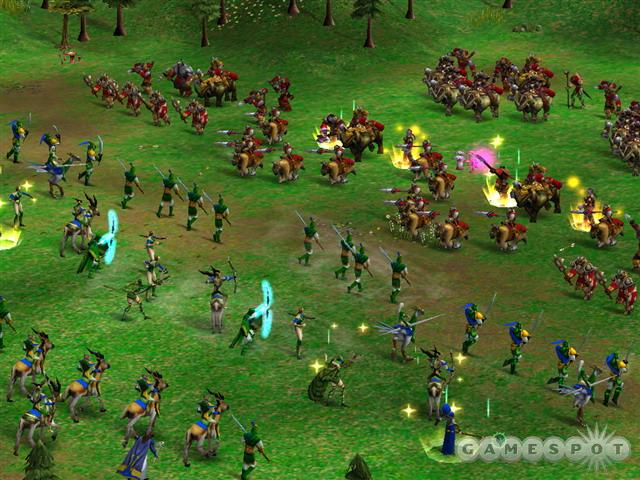Kohan II: Kings of War Hands-On Impressions
After playing an early version of Kohan II, we know that developer TimeGate is on the right track.
The original Kohan: Immortal Sovereigns burst upon the scene in 2001 and introduced a new model of fantasy-themed real-time strategy--one that actually emphasized strategy and did away with unit micromanagement and large-scale resource gathering. The result was that you could focus more on the big picture rather than on the minutiae, and Kohan: Immortal Sovereigns was a breath of fresh air in a genre that was seemingly stuck in a rut. Now with the sequel, developer TimeGate Studios faces the challenge of improving on the original and broadening its appeal without losing the elements that made the original great. We've been putting an early version of the game through its paces, and the good news is that Kohan II is shaping up to be a worthy successor.
Like the original game, Kohan II is a fantasy-themed RTS built around the ideas of cities and companies. One of the most valuable resources in the game is a city, which can start off as a tiny village and can evolve into a town, then a city, and then, finally, a citadel. Cities are the only source of gold, plus they're the only place where you can muster companies, so naturally they're the linchpin of the game. Whoever can seize the most cities will most often win, and indeed, the goal of the game is to usually wipe out your enemy by capturing his cities. Cities are also important because they exert a supply radius, which signifies their surrounding influence. But, more on this later.
There is no traditional resource gathering per se in Kohan II; you don't have to send out dozens of peons to run around the world to pick up ore or wood. However, there are resources and they do play a critical role. The most important resource is gold, which is used to purchase everything in the game. Then there are four other resources: stone, iron, wood, and mana. While there are a handful of resource nodes on the map that you build mines over to enhance your income rate for these resources, the most common way to generate these resources is by constructing the appropriate building in a city. If you require iron, create a blacksmith, and if you want wood, you need a sawmill, and so on. The key is that you want a positive income rate for each resource. Now, each military company you form requires a certain amount of resources for upkeep; for example, archers use a lot of wood, swordsmen require iron, and magic users need mana. If your wood income is +8, and then you build an archery company, your income will drop down to +2 because the archer company requires a constant supply of six wood. As long as your income rate for a particular resource is positive, you're fine. But if you start to use more of a resource than you can generate, the deficit will be taken out of your gold supply until you can address the issue, and this can cripple your gold income.
Companies are the military units of the game. Instead of having to micromanage dozens of individual units, you form companies of engineers, pikemen, swordsmen, and the like. Each company is composed of between four to six units attached to a captain or hero. This automatically organizes your forces into logical military formations, allowing you to commit dozens of units into battle by just giving orders to a few companies. One thing to keep in mind about companies is that they can gain experience and level up. All companies start off as basic recruits, but if they can survive a few battles they'll become veteran units and gain offensive and defensive bonuses (typically a +1 for defense and +2 for attack). If they can survive more battles, they'll be promoted to elite units, doubling their previous bonuses and making them extremely lethal on the battlefield. And in a fight, it's preferable to have a few elite companies rather than a lot of green ones.

You can also research numerous technologies in your cities that will increase the lethality of your companies by enhancing their defense, attack capabilities, and morale. The latter item plays an important role, because if a company is facing annihilation, the surviving units will break contact and attempt to fall back on their own. As long as a single unit of a company survives, the company can reconstitute back to full strength if it's in the supply radius of a friendly city. Part of being an effective commander is knowing when to pull your forces back to regroup, because if you wait for them to panic, they'll be extremely vulnerable to pursuing forces.
War is Politics
We played a six-player skirmish game, with the artificial intelligence providing both our teammates and opponents. The vaunted non-cheating AI of the original game appears to be as formidable as ever; the computer is particularly good at massing troops and exploiting holes in your defenses. You've got to be on your toes because you can experience some wild reversals of fortune throughout a single match. (In fact, we had our rears handed to us by the AI on several occasions, and this was on the default difficulty setting.) More often than not, a faction will commit several companies in an attack on a city, only to run out of steam with victory in sight. Then with the attacking companies exhausted and depleted, the defender's allies would arrive to repulse the invaders and push them back.

A successful offensive requires you to coordinate closely with your allies so you can mass your efforts. You can issue commands to your teammates--both human and virtual--with just a few clicks of the mouse. If the enemy attacks one of your cities, you can signal for help and defend it with just a few clicks on the mouse. Your allies will receive the message and a flag will appear on the minimap indicating where reinforcements are required. (Whether they actually send anyone is up to them, of course.) You can also use the team commands to coordinate an attack, or to transfer resources and companies to an ally.
The version of the game that we played had four of the game's six unique races: humans, the gauri (a dwarflike race), the drauga (a barbarian-like race), and the undead. The remaining two units remain a secret, since they're apparently vital to the game's story. After you choose which race to play, the next step is to select a political faction. There are five political factions in all, including royalists, nationalists, and ceyah. Political factions are a way to tailor the game to the way you play: If you're a cautious player, you'll like the ceyah faction, because it receives defensive bonuses for its units; if you're an aggressive player, the royalist faction offers attack and morale bonuses; and, if want to overwhelm the enemy, the nationalist faction is able to recruit companies at a cheaper price.
"Accessible" tends to be a buzzword of sorts in gaming, but Kohan II features a much more streamlined interface that makes it easy to understand and play. While the original game required you to click on a myriad of different buttons and menus in order to, say, upgrade the buildings in a town, Kohan II borrows a page from the traditional real-time strategy user interface (most of the controls you need are laid out logically in the bottom right corner of the screen). If you're a veteran of RTS games, then you should feel right at home with Kohan II's interface. It also helps that TimeGate has incorporated all sorts of tool tip-style pop-ups that tell you everything you need to know. Our favorite example of this is when you're deciding whether to build a new unit or building, the game will list your current income and resource rates and offer you a comparison as to how the new unit or building will affect them.

By its nature as a sequel, it's near impossible for Kohan II to be as revolutionary as its predecessor. But from what we've seen, it looks like TimeGate is on the right track to capturing the addictiveness of the original game, while at the same time making it much more accessible to the regular gamer. Even in the early version that we played, Kohan II is a fast-paced, challenging RTS with a lot of depth. We're looking forward to seeing the final version of Kohan II, which is due out sometime this fall. Meanwhile, make sure to check back with us for updates on this promising game.
Got a news tip or want to contact us directly? Email news@gamespot.com

Join the conversation